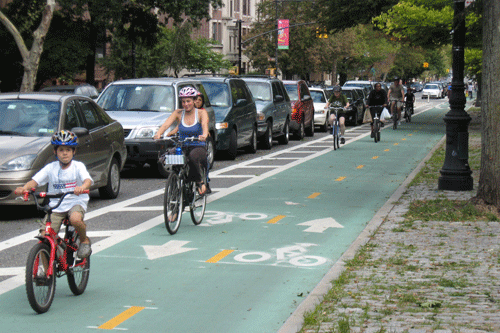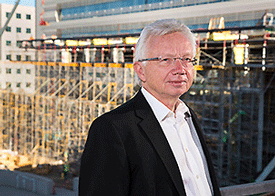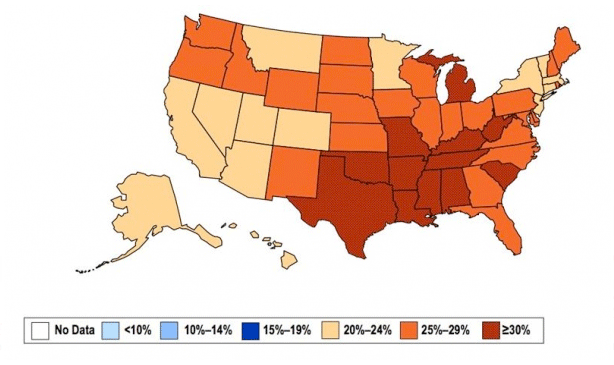Heinz Environment Prize Winner
Air Date: Week of September 21, 2012

Prospect Park Bicycle Path in New York City. (New York City Department of Transportation.)
Pediatrician Richard Jackson won this year’s Heinz Environment Prize. Dr. Jackson believes our built environment is one cause of rising rates of obesity and depression. He explains to host Steve Curwood about that better designed communities could improve public health.
Transcript
CURWOOD: Well, the dangers of toxins to children have been a major concern for Dr. Richard Jackson, the winner of this year's Heinz Environment Prize. A pediatrician, Dr. Jackson built a national reputation looking at the health effects of agricultural chemicals and pollution.
He became director of the National Center for Environmental Health at the Centers for Disease Control and Prevention and he's now a professor of environmental public health at the University of California at Los Angeles. His latest concern is the unhealthiness of our built environment - welcome to Living on Earth, Dr Jackson!
JACKSON: It's good talking to you again, Steve!
CURWOOD: How are you?
JACKSON: I’m great. You know it’s an astonishing shock when someone calls you up and says, you know, ‘We’re going to give you this prize, we’re going to recognize what you’ve been doing.’ Particularly when, for quite a while, people had been saying: why is a pediatrician, a public health doctor, talking about urban planning and design architecture and how we lay out our cities?… you’re not trained to do any of that!

Dr. Richard Jackson
CURWOOD: I want to quote you Dr. Jackson. And that is: “We have built an America that is fundamentally unhealthy.” What do you mean by this?
JACKSON: You know, if you wanted to find a way to make someone out of shape, overweight, and depressed, you probably couldn’t do a much better job than creating an environment where – more than half of the people in America – you cannot buy a carton of milk without getting in a car and riding somewhere.
Getting from one place to another now requires that we get into cars, and for many Americans, the most stressful part of their day is the commute. The nature of being in a car, especially for long commutes - an hour and an hour and a half each way - is isolating. And we’ve seen an epidemic of depression in the United States – four fold increase in the use of anti-depressants in the prime of life, just over the last 20 years.
So as I look at how we built America, we made it hard for people to be fit, harder for people to get affordable, healthy food and harder for us to connect with our families and with our communities.
CURWOOD: So what do we need to do about designing the way that we live? What do we need to do about designing cities?
JACKSON: Really require people to walk and be physically active. So, the average person living in Manhattan weighs about seven pounds less than those living in the most sprawling parts of the United States, and they are more fit.
And, anyone that lives in an urban place – you live in Boston, people who live in San Francisco – you have to walk a lot, it’s not efficient to go by car. When I was young, three quarters of kids in America walked or biked to school, now it’s about 12 percent. Three quarters of the children in California can’t pass the Fitness Gram - a test of their fitness.

US obesity rates in 2010.
And this is very worrisome, both for the health of our country, but in some ways for the economic and social vitality of our country. And the most frightening statistic I’ve heard in the last few months was about the fact that we are now projecting that something like 11 percent of all the people in America having Body Mass Indexes over 40, which means the equivalent of 100 pounds overweight or more.
We cannot deal with this epidemic medically - we’ve got to look at upstream issues. How do we help people eat and afford healthier diets, and how do we build physical activity into their lives, because if we don't turn this around, the costs of this epidemic will crush us.
CURWOOD: So what do we need to do about designing the places where we live? Where are the healthiest places to live?
JACKSON: I worked on a Public Broadcasting video series and we visited a whole series of cities. A couple of my favorites were: Boulder, Colorado… pretty much everyone in Boulder can go about their daily lives, meet their daily needs on a bicycle or on these lovely walking trails, and they’re a way to socialize. Another city I liked very much was Charleston, and mayor Joe Riley, who worked very hard to preserve both the character and the walkability and the downtown life of Charleston, has done a terrific job there as well.
CURWOOD: So, let me add this all up – the way that we live is contributing to an obesity epidemic, to depression, to asthma. You’re setting about to try to change that - but progress so far seems pretty slow to me.
JACKSON: People are already voting with their feet and with their pocket book. About 56 percent of people looking to buy a home in America today want something in a walkable neighborhood. Older folks, the baby-boomers, don’t want to be in distant suburbs, particularly when they lose their driving privileges as they age… and young people, the millennials, have looked at the rat-races that their parents were leading and don't want to duplicate it.
They’re being pulled into urban areas that have lively social scenes and have places where people can walk and play. Our cities are realizing that for them to be economically viable, they’ve got to bring in bright, young people - and that’s where the bright, young people want to be - in places that meet their physical, their social, their cultural, and intellectual needs.
CURWOOD: Early in your career you focused a lot on environmental contaminants, pesticides. And this month, September, 2012, is 50 years on from when Rachel Carson published her book Silent Spring. Tell me, how did Rachel Carson’s work influence your work - what do you think of Rachel Carson and her legacy?
JACKSON: Rachel Carson was remarkable. She brought about the first pesticide laws as she described the environmental impacts of DDT and a series of other chemicals we were using. I hope that if Rachel Carson were with us today, she wouldn’t say “Oh, I failed.” I think she would be very worried about the trajectory we are on.
Our current way of regulating chemicals, frankly, doesn’t work very well at this point. We spend 20-25 years researching a chemical and then when we discover ‘Oh, it’s a carcinogen’ ‘Oh, it causes this reproductive hazard,’ the manufacturer changes a chlorine for a bromine and puts a new version out on the market and all over again we have to start this. And so, the toxic substance control laws really need to be brought into the 21st century.
CURWOOD: Dr. Richard Jackson is Professor of Environmental Public Health at the School of Public Health at UCLA and winner of this year’s Heinz Award for the Environment. Thank you so much, Dr. Jackson!
JACKSON: It's a pleasure to talk to you, Steve!
Links
Living on Earth wants to hear from you!
Living on Earth
62 Calef Highway, Suite 212
Lee, NH 03861
Telephone: 617-287-4121
E-mail: comments@loe.org
Newsletter [Click here]
Donate to Living on Earth!
Living on Earth is an independent media program and relies entirely on contributions from listeners and institutions supporting public service. Please donate now to preserve an independent environmental voice.
NewsletterLiving on Earth offers a weekly delivery of the show's rundown to your mailbox. Sign up for our newsletter today!
 Sailors For The Sea: Be the change you want to sea.
Sailors For The Sea: Be the change you want to sea.
 The Grantham Foundation for the Protection of the Environment: Committed to protecting and improving the health of the global environment.
The Grantham Foundation for the Protection of the Environment: Committed to protecting and improving the health of the global environment.
 Contribute to Living on Earth and receive, as our gift to you, an archival print of one of Mark Seth Lender's extraordinary wildlife photographs. Follow the link to see Mark's current collection of photographs.
Contribute to Living on Earth and receive, as our gift to you, an archival print of one of Mark Seth Lender's extraordinary wildlife photographs. Follow the link to see Mark's current collection of photographs.
 Buy a signed copy of Mark Seth Lender's book Smeagull the Seagull & support Living on Earth
Buy a signed copy of Mark Seth Lender's book Smeagull the Seagull & support Living on Earth

